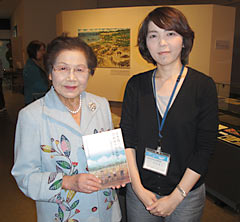Himeyuri students publish new book telling the invisible wounds of the war

At the Himeyuri Peace Museum in Itoman, together with the guide, Akiko Nakada, the director of the museum, Yoshiko Shimabukuro (left) holds up a copy of the new book.
December 25, 2012, Michiyo Kuniyoshi of Ryukyu Shimpo
The Himeyuri Peace Museum has published a new book entitled Himeyuri Students who survived — the path home from the internment camp. At the museum, the Himeyuri stories in the exhibitions or in printed materials are mainly focused on what happened during the battle, which for them was from March 23 in 1945 when the Himeyuri students were mobilized to the Japanese army hospital, until June 18 when the dissolution order was given. The new publication provides readers with a different focus on their lives after survival in the internment camp until they were reunited with their families. The director of the museum, Yoshiko Shimabukuro says, “After they were captured, the students were constantly thinking about their lost friends. We would like to let the younger generation know what it was like after surviving, that the students were struggling and suffered from invisible wounds.”
The new book consists of the personal notes of 24 students. They are divided into two categories: “The path from the internment camp to home,” and “Looking for the remains of friends.” The book was edited to be easy to read, and includes some notes written by the museum curators as well as some old pictures.
Hisa Tsuhako wrote about her experience of being captured after the dissolution order and taking care of orphans at Hyakuna in Tamagusuku. Her story explains how when a typhoon hit Okinawa after the war, children thought that the war had started over again, and she had to carry them and find shelter while they were crying out their parents for help.
Fumiko Higa wrote about finding the remains of her friends at Odo beach in Itoman. She wrote about a heartrending scene in which bereaved families collected stones instead of bones, placing them in an urn and talking to them, saying, “Let’s go home,” as though they were their lost family members.
At the museum, the exhibition Himeyuri Students who Survived will continue until March 31 next year. A guide at the museum, Akiko Nakada says, “We thought that it would be important to tell the untold stories about students’ lives after the war and about the period until this museum was created.” The book can be purchased at the museum for 1500 yen.
(English translation by T&CT, Kyoko Tadaoka and Mark Ealey)
Previous Article:Agibari parade held at Kowan in Urasoe
Next Article:United States plans to deploy CV-22 Osprey in Japan
[Similar Articles]
- Picture books about Himeyuri and Zuisen students published
- Descendants of the Himeyuri Peace Corps visit the battlefield where the student nurses were mobilized for the 30-year anniversary of the Himeyuri Peace Museum
- Moving song about Himeyuri students
- Himeyuri Peace Museum attracts visitors with Takako Miyahira video
- Himeyuri Peace Museum plans second renewal after first in 2004 with new exhibits to pass down history
 Webcam(Kokusai Street)
Webcam(Kokusai Street)


